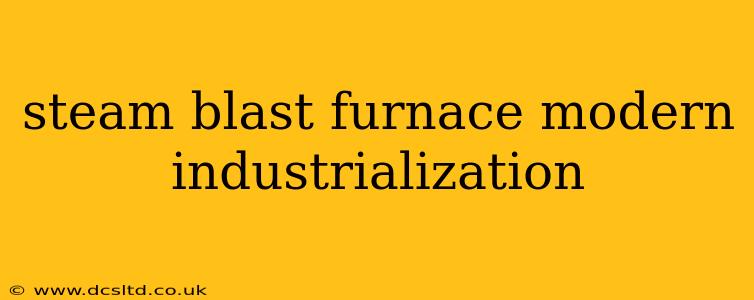The steam blast furnace represents a significant advancement in metallurgical processing, offering a more efficient and environmentally friendly alternative to traditional blast furnaces. This technology leverages the power of steam injection to optimize the reduction process, leading to considerable improvements in energy efficiency, reduced emissions, and enhanced productivity. This article delves into the intricacies of this modern marvel, exploring its mechanisms, benefits, and future potential.
How Does a Steam Blast Furnace Work?
Unlike traditional blast furnaces that primarily rely on hot air for iron ore reduction, steam blast furnaces incorporate superheated steam into the process. This steam, injected at high pressure, undergoes several crucial reactions within the furnace:
- Hydrogen Production: The steam reacts with the coke (carbon source) to produce hydrogen and carbon monoxide. This hydrogen plays a significant role in the reduction of iron oxides, leading to a more efficient reduction process compared to using only carbon monoxide.
- Reduced Energy Consumption: The exothermic reaction between steam and coke generates heat, reducing the overall energy required for the furnace operation. This translates into lower operating costs and a smaller carbon footprint.
- Enhanced Reaction Kinetics: The introduction of steam enhances the reaction kinetics within the furnace, leading to faster reduction rates and improved productivity. This is because hydrogen, being a more reactive reducing agent than carbon monoxide, reacts faster with the iron oxides.
- Improved Metal Quality: The controlled addition of steam can help optimize the chemical composition of the produced iron, resulting in higher quality metal.
What are the Advantages of Using a Steam Blast Furnace?
The advantages of steam blast furnaces are multifaceted and significant:
- Increased Efficiency: As mentioned, steam injection leads to significantly improved energy efficiency, reducing the overall fuel consumption.
- Environmental Benefits: Reduced reliance on fossil fuels translates to a considerable reduction in greenhouse gas emissions and other pollutants. This aligns with global efforts towards sustainable industrial practices.
- Higher Productivity: Faster reduction rates contribute to higher throughput and overall increased productivity of the furnace.
- Improved Metal Quality: The controlled addition of steam aids in producing high-quality iron with optimized chemical composition.
- Lower Operating Costs: The combination of increased efficiency and productivity leads to lower operational costs, making the process more economically viable.
What are the Challenges Associated with Steam Blast Furnace Technology?
Despite its advantages, the steam blast furnace technology faces some challenges:
- High Initial Investment: The initial investment for installing and commissioning a steam blast furnace can be substantial, potentially deterring smaller companies.
- Material Requirements: The process requires high-quality steam and sophisticated materials capable of withstanding high temperatures and pressures.
- Process Control: Precise control of steam injection and other furnace parameters is crucial for optimal performance. Advanced control systems are required.
- Corrosion: The high temperatures and the presence of steam can lead to increased corrosion of furnace components, necessitating careful material selection and regular maintenance.
What are the Future Prospects of Steam Blast Furnace Technology?
The future of steam blast furnace technology appears promising. Ongoing research and development focus on:
- Optimizing Steam Injection Strategies: Advanced modeling and control techniques are being developed to further optimize the steam injection process, maximizing efficiency and reducing emissions.
- Developing Advanced Materials: Research into developing materials with enhanced corrosion resistance is crucial for extending the lifespan of furnace components.
- Integration with Renewable Energy Sources: The integration of steam blast furnaces with renewable energy sources, such as solar or geothermal energy, could further reduce their environmental impact.
Is Steam Injection Suitable for All Blast Furnaces?
The suitability of steam injection depends on several factors, including the existing furnace design, the quality of raw materials, and the desired product specifications. Retrofitting existing blast furnaces for steam injection might not always be feasible or economically viable. Therefore, careful evaluation is crucial before implementing this technology.
What are the Environmental Impacts of Steam Blast Furnaces Compared to Traditional Methods?
Compared to traditional blast furnaces, steam blast furnaces offer considerable environmental advantages due to their reduced reliance on fossil fuels and lower greenhouse gas emissions. They are a significant step towards more sustainable and environmentally responsible iron production.
How Does Steam Injection Affect the Quality of the Produced Iron?
Controlled steam injection can lead to improved iron quality by optimizing the chemical composition and reducing impurities. The precise effects depend on the specific operational parameters and the characteristics of the raw materials.
In conclusion, the steam blast furnace represents a significant leap forward in iron production. While challenges remain, the advantages in efficiency, environmental impact, and overall productivity make it a promising technology for the future of metallurgical processing and modern industrialization. Further research and development will be crucial in overcoming existing challenges and fully realizing the potential of this revolutionary technology.
